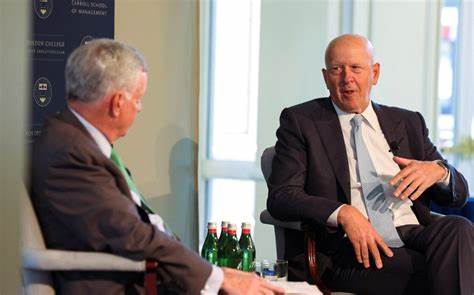In a recent address at Boston College, Goldman Sachs CEO David Solomon provided a nuanced perspective on the Federal Reserve’s interest rate policy and the broader economic landscape, offering insights that diverged from prevailing market sentiment. Solomon’s remarks shed light on the complexities and uncertainties facing policymakers and market participants alike.
At the core of Solomon’s comments was his departure from prevailing market expectations regarding the Federal Reserve’s stance on interest rates. While market sentiment had been leaning towards at least one rate cut by the Fed in response to economic conditions, Solomon expressed skepticism about such a move. He underscored the potential for “stickier inflation,” suggesting that the Fed may be hesitant to cut rates amidst concerns about inflationary pressures.
Solomon’s perspective was informed by recent developments, including the minutes of the Federal Reserve’s April 30-May 1 policy meeting. These minutes had hinted at a cautious approach to rate cuts, with policymakers preferring to wait and ensure that inflation is on track to reach its 2% target before making any adjustments to monetary policy.
During his address, Solomon delved into the nuances of the US economy, highlighting its fundamental strength while also acknowledging disparities in growth and the impact of inflation across different segments of society. He emphasized the cumulative nature of inflation, citing anecdotal evidence from a conversation with a grocery chain CEO who had observed changes in consumer behavior in response to rising prices.
In addition to his assessment of the US economy, Solomon addressed broader challenges to global growth, including geopolitical uncertainties and the need for a comprehensive industrial policy within the US. He underscored the importance of proactive measures to address these challenges, advocating for investments in infrastructure to support the transition to electric vehicles and the integration of AI technologies into existing systems.
Overall, Solomon’s remarks reflected a nuanced understanding of the interconnected factors shaping economic conditions. By offering insights into the Fed’s interest rate policy and highlighting key economic trends, Solomon provided valuable perspectives for investors, policymakers, and other stakeholders navigating uncertain economic terrain.
Solomon’s comments serve as a reminder of the intricacies involved in economic forecasting and policy-making. While market sentiment may often lean towards certain outcomes, the reality is often more complex, with multiple factors influencing economic trends and policy decisions. As such, Solomon’s insights offer a valuable counterbalance to prevailing narratives, encouraging a more nuanced and informed approach to economic analysis and decision-making.
